Minnesota Starwatch
Minnesota Starwatch by Deane Morrison, designed to inform the broadest possible community of the appearance of the nightly sky and current activities in newspapers, continues to be published in several newspapers throughout the state.
Contact:
Deane Morrison
University Relations
(612) 624-2346
morri029@umn.edu
DECEMBER 2022
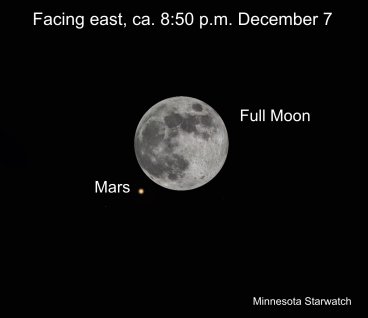
On the night of December 7-8, Earth finally catches up to Mars in the orbital race. Mars will then be opposite the sun in the sky and so up all night—not to mention gloriously bright.
But despite this being its big night, Mars gets upstaged by December’s full moon. On the evening of the 7th, the moon occults—that is, passes in front of—Mars. The exact time of Mars’ disappearance varies with location, but it will happen near 9 p.m. To watch this spectacle, grab your binoculars, get outside early, and keep an eye on the moon as it closes in on Mars. The red planet will reappear on the other side of the moon approximately an hour after disappearing.
Saturn is edging toward the western horizon, with brilliant Jupiter not far behind. A waxing moon visits Saturn on the 26th, Jupiter the 28th and 29th.
Mercury and Venus pop up into the sunset glow in mid-month. However, Mercury may be lost in the glare and Venus could be hard to find until late in the month. The best day to look is the 24th, when a young crescent moon shines to the left of the planets. Mercury soon falls out of the sky, but Venus remains an “evening star” until well into next summer.
The bright winter stars and constellations will be assembled in the east by about 10 p.m. on the 1st, then earlier each night. Mars sails high above Betelgeuse, the gigantic red star at Orion’s right shoulder. See if you can make out the reddish colors of these two beacons. Compare them to the brilliant white of Sirius, the lowest of the iconic winter stars.
The winter solstice arrives at 3:48 p.m. on the 21st. At that moment the sun reaches a point above the Tropic of Capricorn and begins its journey back north.
NOVEMBER 2022

As night falls on November 1, a just-past-first-quarter moon hangs below Saturn, with brilliant Jupiter off to the east. The moon continues to wax as it glides between the two planets on the 2nd and 3rd and below Jupiter on the 4th.
Between and well below the planets shines Fomalhaut, dubbed the “loneliest star” due to being located nowhere near any other bright stars. Fomalhaut represents the mouth of Piscis Austrinus, the southern fish, an extremely dim constellation.
November’s full moon undergoes a total eclipse in the early hours of the 8th. The eclipse begins at 3:09 a.m., when the moon starts to enter Earth’s dark inner shadow. Totality lasts from 4:16 to 5:41 a.m., with maximum eclipse at 4:59 a.m. The eclipse ends at 6:49 a.m.
As the moon darkens, the bright winter stars come into their full glory, complete with special guest Mars. The Pleiades star cluster glimmers above the moon, and Aldebaran, the eye of Taurus, the bull, shines to the east of the Pleiades. Aldebaran and Betelgeuse—at Orion’s right shoulder—form a nearly equilateral triangle with Mars; the red planet will be the highest of the three.
Mars rises in the northeast about two and a half hours after sunset on the 1st and appears earlier every evening. This is a great month to watch Mars, not only because it’s rising in convenient evening hours but because it’s rapidly brightening as Earth gains on it in the orbital race. Mars reaches its peak brightness in early December, when Earth finally catches up to it.
The Leonid meteor shower peaks after midnight on the mornings of the 17th to 19th. This can be an exciting shower; however, for most of this year’s show a waning but still bright moon will interfere.
OCTOBER 2022
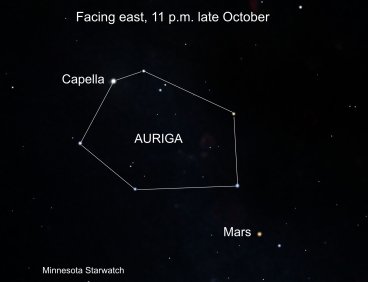
The nights are getting longer and darker, but brilliant Jupiter provides a beacon until well into the morning hours.
The king of planets comes out in the east at nightfall and dominates the sky. West of Jupiter shines Saturn, and above the ringed planet, the Summer Triangle of stars still rides high. A waxing moon passes Saturn between the 4th and 5th and Jupiter between the 7th and 8th.
The two giant planets are now drifting through the dim autumn “water” constellations Capricornus, the sea goat; Aquarius, the water bearer; and Pisces, the fishes. Above Jupiter, the Great Square of Pegasus, the winged horse, is easy to find. Looking below the Great Square and to the upper right of Jupiter, see if you can make out the faint ring of stars known as the Circlet of Pisces. If skies are dark, you can find all these stars and constellations, but you’ll probably need a star chart.
Farther east, Mars is now rising before midnight. The red planet appears below the roughly hexagonal form of Auriga, the charioteer, and its crown jewel, Capella. With Earth rapidly gaining on it in the orbital race, Mars waxes brighter every night.
October’s full moon rises on the evening of the 9th. It will be about as round as it gets and lovely against a pale sky.
October ends with an astronomically based holiday. Halloween began as the Celtic holiday Samhain (“SAH-win”), which marked the beginning of the dark half of the year and was one of four cross-quarter days falling midway between an equinox and a solstice. On that night, evil spirits that had been cooped up since May Day were set loose upon the world. To ward off the spirits, people left bribes of food and lit candles in hollowed-out gourds. Those practices led to our traditions of trick-or-treating and carving jack-o’-lanterns.
SEPTEMBER 2022
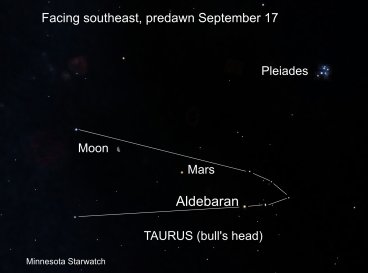
September’s mild nights and darkening skies make for some of the year’s best star watching.
In the west, brilliant Arcturus is slowly sinking, dragging its kite-shaped constellation, Bootes, the herdsman, with it. Just east of Bootes hangs the semicircular Corona Borealis, or northern crown; its sole bright star is called Gemma or Alphecca. Moving east again, an hourglass of stars defines the torso of upside-down Hercules.
Next to Hercules shines Vega—the beacon of Lyra, the lyre, and the brightest of the large Summer Triangle of stars. This month, the Triangle will be high in the south at nightfall—that is, in prime viewing position at the prime viewing hour. Below Vega, a small parallelogram of stars outlines the lyre. Moving east again, somewhat dimmer Deneb, also a Triangle star, marks the tail of Cygnus, the swan, and the head of the Northern Cross. To the south, Altair, in Aquila, the eagle, forms the sharpest point in the Triangle. And slightly above and east of Altair, little Delphinus, the dolphin, leaps into a dark sea.
September’s full moon rises the evening of the 9th. It crosses the night sky between Saturn, to the west, and Jupiter, to the east. On the morning of the 17th, Mars will be sandwiched between Aldebaran—the eye of Taurus, the bull—and a very high last quarter moon. Last quarter moons near the fall equinox always ride high, because at this time of year the Northern Hemisphere tilts toward their position.
The equinox arrives at 8:03 p.m. Thursday, the 22nd, when the sun passes over the equator into the southern sky and an observer from space would see Earth lighted from pole to pole.
Earth laps Jupiter in the orbital race on the 26th. That event places Jupiter opposite the sun in the sky, so it will be up all night.
AUGUST 2022
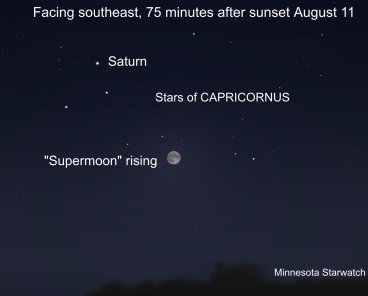
In the predawn sky, four planets—Venus, Mars, Jupiter and Saturn—are still strung in that order from left to right. But now the line of planets stretches all the way across the sky.
Venus dazzles from low in the northeast. Mars and Jupiter begin the month well up in the southeast and south, respectively, with Saturn lower in the southwest. As August goes by, Jupiter and Saturn drift westward; at month’s end, Saturn will be so far west that it sets before Venus appears. On the 14th, Earth laps Saturn in the orbital race. On that day Saturn will be almost exactly opposite the sun in the sky, so it will shine all night.
On the evening of the 11th, we get to watch another “supermoon” rise. It’ll be not only much closer to Earth, and brighter, than usual, but also about as round as it gets, since perfect fullness occurs close to the time of moonrise. Saturn accompanies this gorgeous moon across the night sky, while Jupiter does the honors the night of the 14th. On the morning of the 19th, a last quarter moon appears between Mars and the Pleiades star cluster. And on the 25th, Venus rises below an aging crescent moon—that will be lovely.
In the second half of the month, we’ll have at least an hour of moon-free star watching after nightfall. Start in the west with brilliant Arcturus, the anchor of kite-shaped Bootes, the herdsman. Hanging slightly to the east of Bootes is the semicircular Corona Borealis, or northern crown; its jewel is called Gemma or Alphecca. Next comes an hourglass of stars marking the upside-down torso of Hercules. And just beyond Hercules shines the large Summer Triangle of stars. Vega, the brightest of the three, dominates the constellation Lyra, the lyre, and rivals Arcturus in brilliance.
This year’s Perseid meteor shower is predicted to peak in the predawn hours of the 12th or 13th. However, the moon will wash out all but the brightest meteors.
JULY 2022

July opens with four morning planets—Venus, Mars, Jupiter and Saturn—strung out in that order from northeast to south. By month’s end, Saturn will be moving into the southwest and both Saturn and Jupiter start rising before midnight.
Earth laps Saturn in the orbital race on August 14, and we catch up to Jupiter on September 26. As for Mars, it’s getting steadily brighter, but we won’t lap it until early December. If you’re unsure which object is Mars—or even if you’re quite sure—you may want to get outside just as day starts to break on the 22nd, when a waning crescent moon will be about midway between the Red Planet and the lovely Pleiades star cluster.
Venus lingers very low in the east to northeast, but with the morning sky staying dark longer each day, we don’t have to get up quite so early to catch it.
In the evening sky, Scorpius scrapes the southern horizon at nightfall. On the 10th, a waxing moon will be close to the scorpion’s heart, the gigantic red star Antares. High above Scorpius shine two brilliant stars. To the west, Arcturus anchors the kite-shaped constellation Bootes, the herdsman. To the east, Vega ornaments the smaller constellation Lyra, the lyre. Vega is also the brightest of the Summer Triangle of stars, which also includes Deneb, in Cygnus, the swan; and Altair, in Aquila, the eagle.
July’s full moon will be another big, luminous supermoon. It gets its large size by arriving on the 13th, the same day it swoops closest to Earth in this lunar cycle.
On July 4, Earth reaches aphelion, its farthest distance from the sun: 94.5 million miles. On that day we’ll be moving most sluggishly in our orbit—18.2 miles per second, compared to 18.8 miles per second when we’re closest to the sun.
JUNE 2022
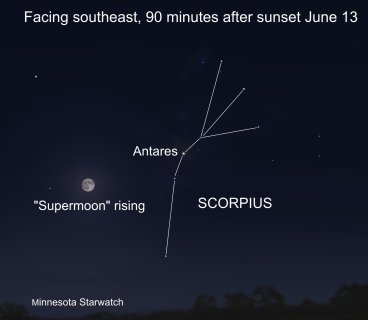
June begins with Jupiter sailing away from Mars, moving ever higher and westward above the predawn eastern horizon.
About 75 minutes before sunrise, Venus will be quite low in the east. To the upper right of the brilliant planet will be Mars, and to its upper right will be bright Jupiter. West of Jupiter, you’ll see Saturn well up in the southeast.
With a clear sky, an unobstructed view of the eastern horizon, and binoculars, you may spot Mercury in the sun’s foreglow, to Venus’ lower left, between about the 17th and the 25th. Once Mercury is up, all five planets visible to the naked eye will be strung out in an arc from left to right in the order Mercury, Venus, Mars, Jupiter and Saturn—the same order as their distances from the sun.
However, the sun will probably begin to wash out Saturn and Mars before Mercury appears. So be sure to look for Saturn and Mars by 75 minutes before sunrise, then try to spot Mercury about a half-hour later.
The night of the 13th-14th, June delivers a large and gorgeously bright “supermoon.” It gets its beauty by reaching fullness at 6:51 a.m. on the 14th—less than 12 hours before perigee, its closest approach to Earth in a lunar cycle. Unfortunately, on that morning the moon sets before reaching fullness. To catch it, check your local time of moonset and look to the southwest 20 minutes beforehand. Or, just watch the moon rise against a sunlit sky the evening of the 13th.
Summer arrives officially with the solstice at 4:13 a.m. on the 21st, when the sun reaches a point over the Tropic of Cancer. At that moment Earth will be lighted from the Antarctic Circle up to the North Pole and beyond to the Arctic Circle on the dark side of the planet.
MAY 2022
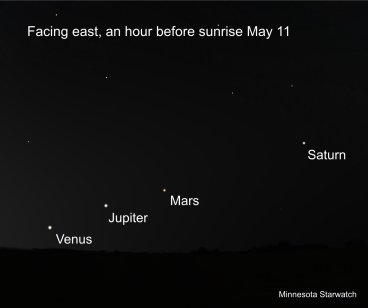
May opens with the two brightest planets low and close together in the eastern morning sky. Jupiter will be just above brilliant Venus, in the act of passing it en route to a rendezvous with Mars.
The Red Planet will be glimmering to the upper right of the pair. Jupiter rapidly closes in on Mars and catches it on the 29th, when it will appear close above Mars.
Jupiter continues along the same path toward Saturn, but the ringed planet moves steadily westward, away from Jupiter, too fast to catch.
That’s because Saturn, the most distant from the sun of the three bright outer planets, orbits most slowly. Thus, Earth’s orbital motion pushes it most rapidly westward across the sky. Mars, being the closest and speediest of the three, resists the push and lingers in the eastern sky the longest.
To see the planets, try to get outside just before the sky starts to lighten.
In the evening sky, Leo, the lion, is high in the south at nightfall on May Day. The brilliant star in the southeast is Arcturus, in kite-shaped Bootes, the herdsman. Below and slightly west of Arcturus is Spica, the brightest star in Virgo, the maiden. All these stars move westward as the hour and the calendar move forward.
May’s full moon treats us to a total lunar eclipse the night of the 15th-16th. The eclipse begins at 9:27 p.m. May 15, when the moon first contacts Earth’s umbra—the inner part of its shadow, where the sun is completely blocked. Totality lasts from 10:29 p.m. to 11:53 p.m. The moon is deepest within the umbra at 11:11 p.m. After totality ends, the moon will be partially eclipsed again until 12:55 a.m. May 16. Let’s hope for clear weather that night.
APRIL 2022
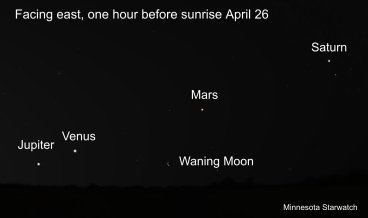
As April opens, the stage is set for some serious planetary action in the morning sky.
On April Fools’ Day, Venus, Saturn and Mars sit close to each other above the eastern horizon, almost equally spaced and in that order from left to right. But don’t be fooled; Saturn is rapidly gaining altitude, and on the 5th it passes less than a moon width above Mars. As the month goes on, the three planets spread farther and farther apart while staying in a line. On the 25th, Mars will be exactly midway between Saturn and Venus.
Around the 21st, Jupiter appears to the lower left of Venus; the gap between them narrows rapidly. Try looking on the 25th or 26th, when a waning moon appears with the planets, or on the 30th or May 1, when Jupiter passes above Venus. But whichever day(s) you choose, it’s best to get out just as day starts to break, to ensure all the expected objects have risen but none have yet been swallowed by the sun’s foreglow.
In the evening sky, the spring constellation Leo, the lion, is high in the southeast to south at nightfall. Leo’s brightest star, Regulus, anchors a backward question mark of stars called the Sickle, which outlines the lion’s head. East of the Sickle shines a triangle of stars marking the hindquarters and tail.
Look between Regulus and Pollux, the brighter Gemini twin, for the Beehive star cluster. It’s slightly closer to Pollux, and you may need a star map or binoculars. The Beehive is also called Praesepe, Latin for “manger.” Framing the cluster are two stars called Aselli, or asses, that feed at the manger.
April’s full moon crosses the sky the night of the 16th. It follows Spica, the brightest star in Virgo, the maiden. Virgo is large and rather dim, but you may notice Corvus, the crow, an irregularly shaped four-sided figure just west of Spica.
MARCH 2022
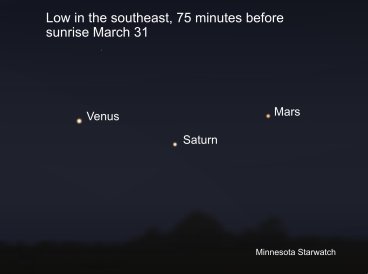
As its namesake month begins, Mars glimmers below brilliant Venus in the predawn sky. To the right (south) of the planets sits the Teapot of Sagittarius, while the curved Teaspoon of stars hangs above and between the Teapot and the planets. Moving south again, look for the sinuous form of Scorpius and its red heart, Antares.
Mars inches upward all month long, and Saturn climbs over the horizon in mid-month. The ringed planet passes below Venus between the 27th and 28th, and ends March below and between its two fellow planets. A waning moon visits Antares on the 23rd, then sails toward the planets. At 5:47 a.m. on the 28th, a scrawny old crescent moon rises below the three planets. But to see all four objects, you’ll have to look soon after moonrise, or the sun will have washed out at least some of the planets.
In the evening sky, the large knot of bright winter constellations makes its last stand in March. If you haven’t seen them, look to the south to southwest at nightfall. Enjoy Sirius, in Canis Major, the big dog, at the bottom of the group, then look up to brilliant Capella, at the top in Auriga, the charioteer. The starry assemblage is so tall, you’ll have to lean your head back to see Capella.
March’s full moon shines the night of the 17th-18th from below the tail of Leo, the lion As the night goes on, the moon and the lion seem to drive the winter constellations westward.
The spring equinox arrives at 10:33 a.m. on the 20th. At that moment, the sun crosses the equator into the northern sky and an observer in space would see Earth lighted from pole to pole. Also, the spring equinox ushers in six months during which the day length increases as we travel north. And even if we stay put, we experience the fastest increases in day length near this equinox because it’s the time of year when the sun moves most rapidly northward.
FEBRUARY 2022

All month long, the knot of bright winter constellations occupies center stage in the south during the prime early evening viewing hours. This grouping boasts five stars that rank among the top ten brightest in the night sky: Sirius (No. 1), Capella (No. 6), Rigel (No. 7), Procyon (No. 8) and Betelgeuse (No. 10).
At nightfall Sirius shines from Canis Major, the big dog, while above and slightly to the east twinkles Procyon, in Canis Minor, the little dog. Both are near neighbors of the sun, so no wonder they appear so bright. Sitting atop the stellar panoply, Capella, in Auriga, the charioteer, is four times more distant than either Sirius or Procyon. But the two stars in Orion—Betelgeuse, at his right shoulder, and Rigel, at his left foot—hold their own against the others despite being more than 10 times farther away than even Capella.
A waxing moon passes between the horns of Taurus, the bull, on the night of the 10th and between the bodies of the Gemini twins on the night of the 12th. On the 13th, the “head” stars of the twins—Pollux (the brighter) and Castor—form a nearly straight line with the moon. February’s full moon shines from the jaws of Leo, the lion, the night of the 15th.
In the morning sky, brilliant Venus, in the southeast, spends much of the month climbing toward much dimmer Mars. A waning moon passes Spica, the brightest star in Virgo, the maiden, between the 20th and 21st and visits Antares, the heart of Scorpius, on the 24th. On the 27th, Venus, Mars and an old crescent moon stack up with Mars in the middle. To see all three, look to the southeast just as dawn starts to break.
On Groundhog Day we get a hint of spring. The day was first celebrated as the astronomically based Celtic holiday Imbolc, or lamb’s milk, and heralded the start of the lambing season. It was one of four cross-quarter days falling midway between a solstice and an equinox.
JANUARY 2022
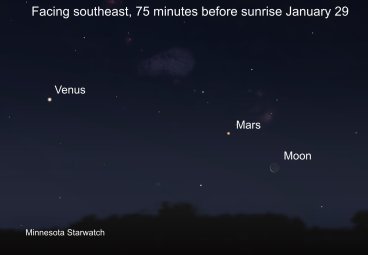
In January Venus emerges from its short trip between Earth and the sun to become a “morning star.” It begins a rapid climb over the southeastern horizon in mid-month, making its way toward much dimmer Mars. Try looking just before the sky starts to lighten on the 29th. Venus will be to the upper left of a thin waning moon and Mars will be between them, but closer to the moon.
The bright star off to the upper right of this assemblage is Antares, the heart of Scorpius. Its name means “rival of Mars,” and for the time being it outshines its planetary competitor.
New Year’s Day sees brilliant Jupiter and dimmer Saturn lingering in the southwest at nightfall. The two planets form a nearly equilateral triangle with Fomalhaut, the brightest star in Piscis Austrinus, the southern fish.
But the triangle breaks in mid-month, when Saturn gets lost in the sunset. The best evening to see the three objects may be Tuesday, the 4th, when a young moon shines to Saturn’s left. Also on that day, Earth reaches perihelion, its closest approach to the sun in its orbit, and achieves its highest orbital speed—which does nothing to help Jupiter resist being left behind in the sunset. By month’s end, the king of planets will be poised to follow Saturn over the horizon.
The first full moon of 2022 rises almost perfectly round before sunset on Monday, the 17th. Within an hour after nightfall, the bright star Procyon, in Canis Minor, the little dog, and radiant Sirius, in Canis Major, the large dog, come out and form a nearly straight line with the moon.
The bright winter stars will all be up in the east by mid-evening on January 1, earlier as the days go by. Brilliant Capella caps the group from its perch in the constellation Auriga, the charioteer, while Sirius—the brightest star in the night sky—holds the “anchor” position.